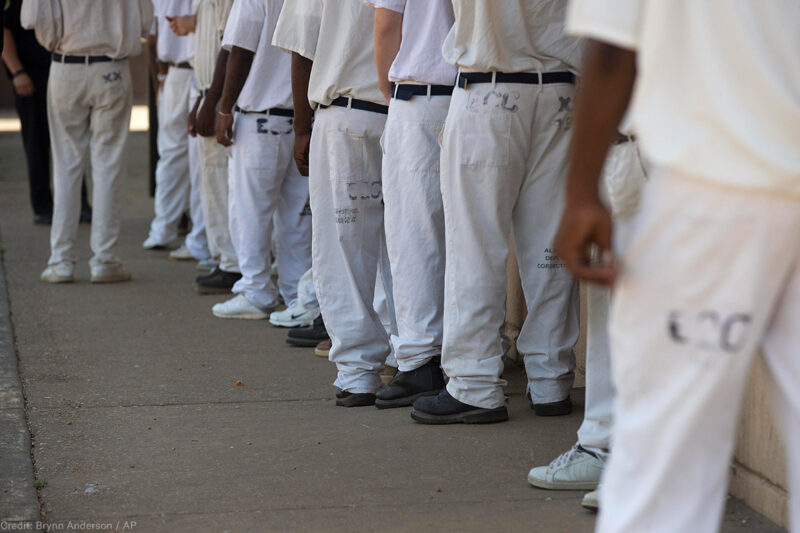
A trove of depicting brutalized and murdered prisoners in Alabama’s St. Clair Correctional Facility has thrust the treatment of our nation’s 2.3 million incarcerated people into public view. The first horror is what these people have endured in prison. The second horror is that while shocking, it is not a surprise.
As a lawyer who has represented prisoners for more than two decades, I have come to expect such violence and degradation of human beings held in appalling conditions like those seen in these photos. The only thing that’s unusual is that, for a brief moment at least, the curtain has been pulled aside and the everyday brutality of our prisons laid bare for all to see.
Transparency is like daylight — applied directly, it can be a disinfectant. And to protect the health and lives of incarcerated people across our country we need full transparency of how they are treated.
That is not the case currently. Prisons are closed institutions, literally walled off from public view. To some extent, this is unavoidable and understandable. While journalists and members of the public can freely wander into the Department of Motor Vehicles, in prisons safety and security considerations preclude similarly unfettered access. Those same considerations require some monitoring and control of communications between prisoners and the outside world.
But to a large extent, the hidden nature of U.S. prisons represents a deliberate policy choice — one that is unique among the democracies we think of as our peer nations.
Many countries have an independent national agency that monitors prison conditions and enforces minimal standards of health, safety, and humane treatment. In Great Britain, has the power to conduct unannounced inspections of all prisons; a similar agency operates in . In countries that have ratified the (OPCAT), prison monitoring by a national oversight body is supplemented by periodic visits by the United Nations Subcommittee on Prevention of Torture.
By contrast, the United States has no independent national agency that monitors prison conditions. The U.S. also has not ratified OPCAT or any other treaty that would provide for outside monitoring. The bipartisan concluded that “[f]ew [U.S.] states have monitoring systems that operate outside state and local departments of corrections, and the few systems that do exist are generally underresourced and lacking in real power.”
Perhaps for this reason, the main vehicle for oversight of conditions in U.S. prisons has been the federal courts. Litigation can permeate prison walls and allow us into the housing units and the solitary confinement cells where prisoners live and die. It allows us to review videos and records otherwise shielded from public view. It allows us to compel prison officials to testify publicly and under oath.
But the federal courts' oversight role has been sharply limited by the 1996 Prison Litigation Reform Act (PLRA). The PLRA subjects lawsuits brought by prisoners in the federal courts to a host of burdens and restrictions that apply to no other litigants. Consequently, there has been a significant decline in judicial oversight of prison conditions. Between 1995 and 2000 alone, the number of states with fewer than 10 percent of their prison populations under court supervision more than doubled, from 12 to 28.
The lack of public knowledge about our prisons has real costs. Most obviously, a lack of oversight facilitates neglect and mistreatment of prisoners and prevents accountability when such misconduct occurs. But there are other consequences as well. Prisons represent the ultimate in big, coercive government — in many states, they represent one of the largest line items in the state budget. They are empowered to confine thousands of people against their will for years or decades and, in some circumstances, to use lethal force against them.
Given these high stakes and the potential for abuse, prisons should be subject to the most exacting scrutiny and public oversight. The reality, though, is just the opposite. Prisons are among the least transparent and accountable government agencies.
Many states ban in-person interviews with prisoners, and prison officials have barred specific journalists whose reporting they considered too critical. Some states have amended their freedom of information laws to limit their application to prisons, even barring prisoners from submitting requests. The federal prison system enacted a rule banning prisoners from publishing their writings under a byline; the rule was later invalidated by a federal court. Arizona went so far as to pass a law making it a crime for prisoners to post information on the internet; that statute, too, was overturned as a violation of the First Amendment.
As long as the public is kept in the dark, horrors like those at the St. Clair Correctional Facility will continue unseen. Increased transparency and oversight are just first steps in correcting the dreadful conditions in our prisons, but make no mistake — the need for them is as immediate as it is urgent.

